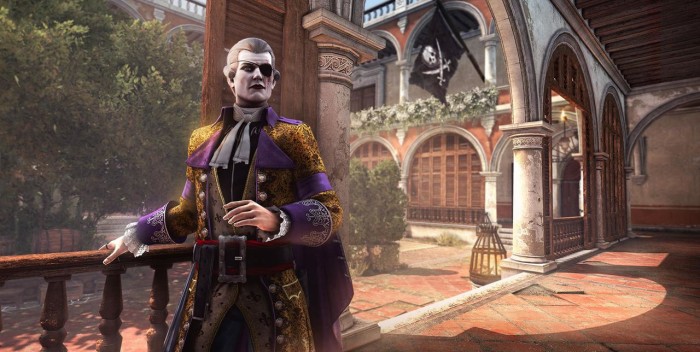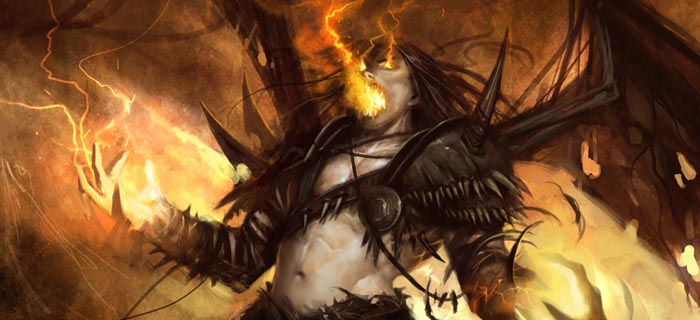AC4 Black Flag multiplayer strategy #3: Identifying Targets with Other Techniques
Welcome to Part 3 in WiNGSPANTT’s Assassin’s Creed 4: Black Flag multiplayer strategy guide!
Line of Sight (LOS)
As with behavioral recognition, internalizing line of sight is a requirement if you want to climb the Abstergo ladder and come out ahead of the competition. Simply knowing its existence isn’t enough; you must practice reading your LOS indicators well enough that you can tell at a glance whether you’re locking onto your victim or not.
The first thing you must understand is that LOS is determined from your character. In other words, seeing a persona on your screen does not indicate line of sight; it’s a literal line of sight between your character’s body and your target’s body. If anything stands between the two of you, your LOS indicator will be staying dark. This system may be unintuitive compared to a camera-based indicator, but that’s just the breaks. There are kids starving out there, I’m sure you’ll get over it.
Gotten over it yet? Great… let’s move on.
The most common and reliable way to leverage LOS is using obstructions to create a hard edge for comparisons between personas. This is most typically called screening, edging, or the corner trick. The latter name is less elegant, but more direct: if you approach a group of characters from around a corner or ledge, some of them will come into your persona’s view before others. By slowly edging toward the obstruction, you will be able to draw more and more imaginary lines of sight to people in the crowd. When your LOS indicator lights up, you have just then made your target visible to your persona.
Basically, you’re eliminating possible targets from the outside (away from the corner) inwards. If you’re coming around a corner on the left towards a group on the right, your LOS will be revealing characters from right-to-left order. For rooftops, edging out over a static blend group will reveal characters farther away from the building first, then characters in the middle of the group, then characters closest to the building. You can also lean over a ledge for complete LOS over anyone who’s standing directly under you (just hold forward without inputting fast walk or high profile actions).
For moving blend groups, you’ll have to set up an ad hoc border to leverage line of sight. Move to an area ahead of the group where you have clear vision of a distinct corner, tree, post, or other obstacle. Hold the lock-on trigger or button, then watch carefully as the blend group makes its way past. Your target portrait and/or radar will stay dark until your real prey slips into view. Immediately engage your lock (release the trigger/button), but make a mental note in case you missed the lock-on window.
If this sounds difficult, it kind of is. Correctly screening your target out of a moving group or from a large number of morphed copies is a skill that will take a long time to master, and still isn’t 100% foolproof. If you’re having a hard time making your decision, it’s better to burn off an ability or use another tactic than to make yourself obvious by constantly slipping in and out of conspicuous corners near your target.
Soft Pushing
The off-hand soft push button can be used to move through crowds, bumping standers-by past your shoulder. But players actually can’t be nudged in this way. If you watch carefully, you’ll notice that while your persona’s hand will still reach up and touch player characters, you won’t actually displace them. If your eye is as sharp as your hidden blade, you can differentiate your target in a small crowd by trying (and failing) to brush past them smoothly.
Of course, this works both ways. NPC’s don’t use the soft push action and they sure as hell don’t comb through crowds against the flow. By using this strategy, you’re exposing yourself (and not in the fun, “let’s get arrested tonight” kind of way) and moving directly into stun range. Act quickly or use the safety of a Smoke Bomb or Disguise if you’re worried about being punched in the face.
Interaction cue
This is going to sound obvious, but bear with me: your target gains an Assassinate prompt when they’re within killing range. You get the same prompt for stunning your pursuers.
That might not sound like a big deal since you already knew that (plus NPCs get the same prompt), but it also means if you don’t have an Assassinate prompt, your currently selected persona is a neutral player. This isn’t the most useful advice for Wanted (and definitely not Assassinate), but for Deathmatch it can help you identify other human beings to avoid or tail, depending on the situation.
For instance, identify and lock onto a player character when you don’t have a contract or a pursuer in Deathmatch. There’s at least a 25% chance that player will soon become your killer or victim, giving you the opportunity to instantly react with stabbing, slapping, kicking, or chiromancy.
Draw distance
To cut down on processing strain, Assassin’s Creed’s engine limits the distance at which NPCs are shown. If you’re standing on top of a building, you may notice that, after a few dozen meters, you just can’t see the crowd anymore.
But what you may not have noticed is that the draw distance for players is slightly farther than it is for NPCs. This means that at extreme distances, you can sometimes identify a player by the simple fact that it’s the only person you can actually see. If you lock on from this range and make a smart approach, you can be certain you’ve found your man. Or woman. Or charlatan.
Please note this effect may vary by platform due to hardware limitations.
Looking for more tips? Head back to the main Assassin’s Creed multiplayer strategy guide index.








[…] Part 3: Identifying Targets with Advanced Techniques […]
Really really useful this. Thanks mate. I’ll tell you what would make this the “Rolls Royce” of tutorials is if you put some YouTube examples of Screening, Soft-Pushes etc. I get it, but it would be so cool to see your skills in action.
Thanks again.